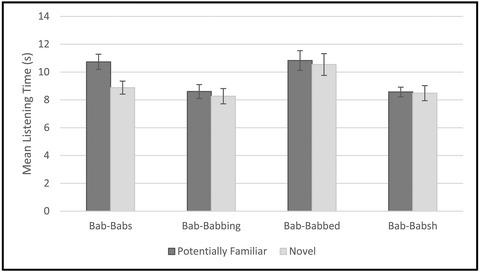Our official English website, www.x-mol.net, welcomes your
feedback! (Note: you will need to create a separate account there.)
6–month–olds are sensitive to English morphology
Developmental Science ( IF 3.1 ) Pub Date : 2021-01-27 , DOI: 10.1111/desc.13089 Yun Jung Kim 1 , Megha Sundara 2
Developmental Science ( IF 3.1 ) Pub Date : 2021-01-27 , DOI: 10.1111/desc.13089 Yun Jung Kim 1 , Megha Sundara 2
Affiliation

|
Each language has its unique way to mark grammatical information such as gender, number and tense. For example, English marks number and tense/aspect information with morphological suffixes (e.g., -s or -ed). These morphological suffixes are crucial for language acquisition as they are the basic building blocks of syntax, encode relationships, and convey meaning. Previous research shows that English-learning infants recognize morphological suffixes attached to nonce words by the end of the first year, although even 8-month-olds recognize them when they are attached to known words. These results support an acquisition trajectory where discovery of meaning guides infants' acquisition of morphological suffixes. In this paper, we re-evaluated English–learning infants' knowledge of morphological suffixes in the first year of life. We found that 6–month–olds successfully segmented nonce words suffixed with –s, –ing, –ed and a pseudo-morpheme -sh. Additionally, they related nonce words suffixed with –s, but not -ing, -ed or a pseudo-morpheme –sh and stems. By 8–months, infants were also able to relate nonce words suffixed with –ing and stems. Our results show that infants demonstrate knowledge of morphological relatedness from the earliest stages of acquisition. They do so even in the absence of access to meaning. Based on these results, we argue for a developmental timeline where the acquisition of morphology is, at least, concurrent with the acquisition of phonology and meaning.
中文翻译:

6 个月大的婴儿对英语形态很敏感
每种语言都有其独特的标记语法信息的方式,例如性别、数字和时态。例如,英语用形态学后缀(例如,-s或-ed)标记数字和时态/方面信息)。这些形态学后缀对于语言习得至关重要,因为它们是语法、编码关系和传达意义的基本构建块。先前的研究表明,学习英语的婴儿在第一年末就可以识别附加到 nonce 单词的形态学后缀,尽管即使是 8 个月大的婴儿在附加到已知单词时也能识别它们。这些结果支持了一种习得轨迹,即意义的发现指导婴儿对形态学后缀的习得。在本文中,我们重新评估了英语学习婴儿在出生后第一年的形态学后缀知识。我们发现 6 个月大的孩子成功地分割了后缀为-s、-ing、-ed和伪语素 - sh 的nonce 词. 此外,他们将后缀为-s 的nonce 词关联起来,但不关联-ing、-ed或伪语素-sh和词干。到 8 个月大时,婴儿也能够将带有-ing和词干后缀的 nonce 词联系起来。我们的结果表明,婴儿从获得的最早阶段就表现出形态学相关性的知识。即使在无法获得意义的情况下,他们也会这样做。基于这些结果,我们主张一个发展时间表,其中形态学的获得至少与音系和意义的获得是同时发生的。
更新日期:2021-01-27
中文翻译:

6 个月大的婴儿对英语形态很敏感
每种语言都有其独特的标记语法信息的方式,例如性别、数字和时态。例如,英语用形态学后缀(例如,-s或-ed)标记数字和时态/方面信息)。这些形态学后缀对于语言习得至关重要,因为它们是语法、编码关系和传达意义的基本构建块。先前的研究表明,学习英语的婴儿在第一年末就可以识别附加到 nonce 单词的形态学后缀,尽管即使是 8 个月大的婴儿在附加到已知单词时也能识别它们。这些结果支持了一种习得轨迹,即意义的发现指导婴儿对形态学后缀的习得。在本文中,我们重新评估了英语学习婴儿在出生后第一年的形态学后缀知识。我们发现 6 个月大的孩子成功地分割了后缀为-s、-ing、-ed和伪语素 - sh 的nonce 词. 此外,他们将后缀为-s 的nonce 词关联起来,但不关联-ing、-ed或伪语素-sh和词干。到 8 个月大时,婴儿也能够将带有-ing和词干后缀的 nonce 词联系起来。我们的结果表明,婴儿从获得的最早阶段就表现出形态学相关性的知识。即使在无法获得意义的情况下,他们也会这样做。基于这些结果,我们主张一个发展时间表,其中形态学的获得至少与音系和意义的获得是同时发生的。











































 京公网安备 11010802027423号
京公网安备 11010802027423号